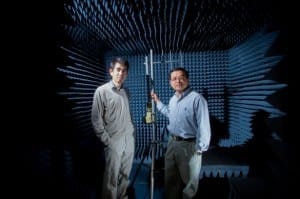New method developed by researchers could have broad impacts on the mobile Internet and wireless industries
Two professors at the University of California, Riverside Bourns College of Engineering have developed a new method that doubles the efficiency of wireless networks and could have a large impact on the mobile Internet and wireless industries.
Efficiency of wireless networks is key because there is a limited amount of spectrum to transmit voice, text and Internet services, such as streaming video and music. And when spectrum does become available it can fetch billions of dollars at auction.
The “spectrum crunch” is quickly being accelerated as customers convert from traditional cell phones to smartphones and tablets. For example, tablets generate 121 times more traffic than a traditional cell phone.
Without making networks more efficient, customers are likely to drop more calls, pay more money for service, endure slower data speed and not see an unlimited data plan again.
Current radios for wireless communications are half-duplex, meaning signals are transmitted and received in two separate channels. Full duplex radios, which transmit signals at the same time in the same frequency band, can double the efficiency of the spectrum.
However, to make a full duplex radio, one must solve a problem: interference between the transmission and receiving functions. The technology of full duplex radio is not yet ready for the current 3G and 4G networks.
The interference caused by signals from cell towers could be billions times more powerful than the ones towers are trying to pick up from a user’s smartphone. As a result, incoming signals would get drowned out.
The UC Riverside researchers have found a new solution called “time-domain transmit beamforming”, which digitally creates a time-domain cancellation signal, couples it to the radio frequency frontend to allow the radio to hear much weaker incoming signals while transmitting strong outgoing signals at the same frequency and same time.
This new solution is indispensable for a full-duplex radio in general while it is complementary to other required solutions or components. The new solution not only has a sound theoretical proof, but also leads to a lower cost, faster and more accurate channel estimation for robust and effective cancellation.
“We believe the future applications of full duplex radios are huge, ranging from cell towers, backhaul networks and wireless regional area networks to billions handheld devices for data intensive application such as FaceTime,” said Liang, who added that the researchers have had discussions with several major wireless telecommunication equipment companies.
Find out more: Facetime on Android
The Latest on: Efficiency of Wireless Networks
[google_news title=”” keyword=”Efficiency of Wireless Networks” num_posts=”10″ blurb_length=”0″ show_thumb=”left”]
via Google News
The Latest on: Efficiency of Wireless Networks
- The wireless technologies driving low latency manufacturingon May 1, 2024 at 4:07 am
The key wireless technologies at play are Wi-Fi 5/6, 5G, and yes, even Bluetooth. All can play a key role in lowering latency and bringing measurable productivity gains to the workshop or factory ...
- Globe harnesses AI, machine learning for enhanced network efficiency, sustainabilityon April 30, 2024 at 6:02 pm
Globe has taken a significant leap forward in enhancing network efficiency and sustainability by implementing an innovative energy management system driven by Artificial Intelligence (AI) and Machine ...
- 5G Versus Wi-Fi 7: Choosing The Right Wireless Technologyon April 30, 2024 at 3:30 am
In the ever-evolving landscape of digital connectivity, comparing the latest between Wi-Fi and 5G technology has become a recurring conversation.
- Tesla Wireless Charging: Is It Possible And When It Will Happenon April 28, 2024 at 5:00 am
Tesla is actively exploring wireless EV charging, eliminating cables for streamlined, efficient charging, once again revolutionizing the EV landscape.
- New model elevates UAV efficiency in next-gen wireless networkson April 23, 2024 at 1:30 pm
Researchers from the University of Missouri-Kansas City, School of Computing and Engineering, and independent researchers have developed a model, dubbed GREENSKY, that significantly enhances the ...
- NTT Research Brings Innovation To Networking And Securityon April 23, 2024 at 1:08 pm
NTT Research, based in Silicon Valley, is pursuing potentially groundbreaking research in vital areas including all-optical networking and enhanced data security.
- New metasurface innovation unlocks precision control in wireless signalson April 22, 2024 at 1:34 pm
Researchers have unveiled a technology that propels the field of wireless communication forward. This cutting-edge design, termed a reconfigurable transmissive metasurface, utilizes a synergistic ...
- RAJANT’S REIOS IoT SOLUTIONS TRANSFORM ENERGY EFFICIENCY AND SAFETYon April 18, 2024 at 4:55 pm
Bringing intelligent insights to all facets of IoT operations through various devices that support the platform’s different applications – Smart Lighting, sTrack, IoT BMS, sDesk, and Smart Picking – ...
- Huawei uses AI to accelerate network intelligenceon April 18, 2024 at 9:05 am
Huawei also said it aims to use AI with the aim of enhancing the competitiveness of the company's products and solutions ...
- Green Radio Communication Networkson November 14, 2022 at 5:00 pm
The importance of reducing energy costs, reducing CO2 emissions and protecting the environment are leading to an increased focus on green, energy-efficient approaches to the design of next-generation ...
via Bing News









